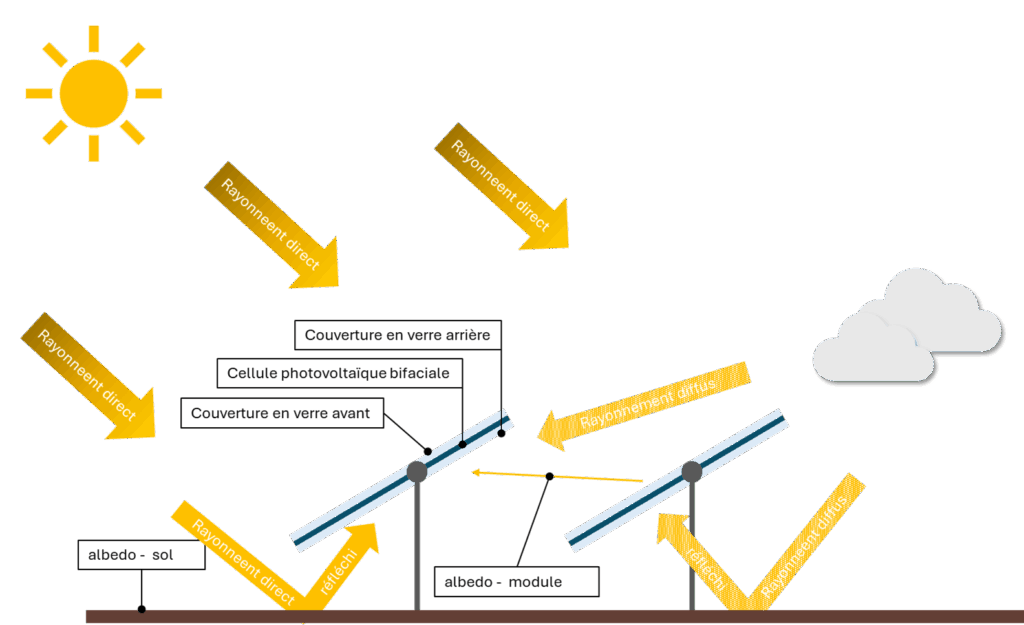This article originate from my contributions to Energiris, a Belgian citizens’ cooperative committed to accelerating the energy transition. As part of our mission to inform and raise awareness among both co-owners and the general public, we regularly publish educational content on topics related to sustainable energy.
The original article was published in French and Dutch, reflecting the multilingual context of our cooperative. By sharing them here in English, I also wish to reflect my personal commitment to a more sustainable and better-informed society.
Originally published on the Energiris website – 27 june 2024
As solar technology evolves, the combination of vertical installation and bifacial panels presents exciting opportunities to optimize space use and energy output — particularly in dense or infrastructure-heavy environments. These innovations could play a meaningful role in scaling up renewable energy without increasing land pressure.
Introduction
Vertical and bifacial photovoltaics are promising technologies for the future of renewable energy. These two innovative approaches aim to maximise solar electricity production while optimising space utilisation. Let’s take a look at how they work and their respective advantages.
The European Commission recently shared the results of an exciting study on the deployment of vertical photovoltaics along roads and railways. This could add additional solar capacity at the European Union level.
What is a vertical and bifacial solar panel?
Vertical photovoltaics involves installing solar panels on vertical structures, such as building walls, bridges, or even creating ‘walls’ along infrastructure (roads, railways, agricultural land, etc.).
The vertical positioning allows for efficient use of limited urban space and reduces shadows cast on adjacent buildings.
When using a bifacial design, the panels generate electricity on both sides:
- the front side directly captures the sun’s energy, using photovoltaic cells to convert solar energy into electricity. Direct sunlight is captured by this front side
- The rear side captures solar energy reflected from the environment, known as the albedo effect. In other words, this side captures sunlight reflected from the ground, buildings or other surrounding surfaces. This reflected light contributes to electricity generation. To maximise the albedo effect, bifaccial panels are designed with a transparent glass rear side. This design allows the reflected light to enter the photovoltaic cells of the panel, thereby increasing energy production compared to conventional photovoltaic panels, which are single-sided.

Advantages and disadvantages of bifacial solar panels
Advantages:
- Higher efficiency (5 to 15% more than conventional panels).
- Increased production, especially in winter.
- Can be used by both private individuals and professionals.
- When facing east-west, they allow production at the beginning and end of the day, during peak electricity consumption. This makes them attractive for balancing a 100% renewable grid.
Disadvantages:
- Slightly higher initial cost.
- Optimal installation required to maximise the albedo effect.
Conclusion
Vertical and bifacial solar panels have a promising future. They could well gradually replace traditional photovoltaic panels.
Want to know more?
- Wikipedia contributors. (2024, 27 May). Bifacial solar cells. https://en.wikipedia.org/wiki/Bifacial_solar_cells
- Kakoulaki, G., Szabo, S., F, F. F., Taylor, N., Gracia-Amillo, A., Kenny, R., Ulpiani, G., Chatzipanagi, A., Gkoumas, K., & Jäger-Waldau, A. (2024). European transport infrastructure as a hub for solar photovoltaic energy. Renewable & Sustainable Energy Reviews, 196, 114344. https://doi.org/10.1016/j.rser.2024.114344
- MonKitSolaire, L. (2023, 1 December). Bifacial solar panels: COMPLETE GUIDE 2024. Mon Kit Solaire. https://www.monkitsolaire.fr/blog/panneau-solaire-bifacial-n343
- Commune, E. (2023, 9 June). The benefits of vertical bifacial panels in agrivoltaics – Renouvelle. Renouvelle. https://www.renouvelle.be/fr/le-bifacial-vertical-dans-lagrivoltaisme/
- (2024, 21 June). Bifacial solar panels: Are they worth it? Nouvel’R Énergie. https://www.nouvelr-energie.com/pv/panneau-solaire-bifacial
- Dubas, C. (2024, 20 March). Adopt vertical green energy: wall-mounted solar panels. Hello Watt. https://www.hellowatt.fr/panneaux-solaires-photovoltaiques/mur-vertical
- Dubas, C. (2024b, 5 June). Bifacial solar panels: advantages, cost, advice. Hello Watt. https://www.hellowatt.fr/panneaux-solaires-photovoltaiques/bifacial
Beyond my role at Energiris, I place great importance on sharing knowledge. I have always considered education to be an essential tool for helping everyone better understand energy issues and the concrete solutions available to us. Sharing what I discover and making complex topics accessible to others is also my way of contributing to a fairer, more inclusive transition.
